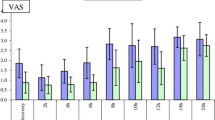Abstract
Aim
There are many alternatives for post-operative pain relief in patients who have had general anaesthesia. The aim of this study was to evaluate the efficacy of intra-articular bupivacaine + morphine and bupivacaine + tenoxicam applications in post-operative pain control in patients undergoing knee arthroscopy with general anaesthesia.
Method
This was a prospective study. Standard anaesthesia procedures were applied to each patient, and the 240 patients chosen at random were then divided into two groups. Each group received a different combination of drugs for this double-blind study. The first group (group A: 120 patients) received 0.5 % bupivacaine 100 mg + tenoxicam 20 mg (22 ml); the second group (group B) received 0.5 % bupivacaine 100 mg + morphine 2 mg (22 ml); both groups received their drugs at the end of the intra-articular operation before tourniquet deflation. Before the operation, patients were asked about their post-operative pain at particular periods over the following 24 hours using the visual analogue scale (VAS) and the numeric rating scale (NRS). An additional analgaesic requirement and possible side effects were also recorded.
Results
Group A patients needed analgaesics sooner after operation than patients in group B. In Group B, VAS and NRS values were statistically higher compared with group A at the 12th hour. There were also fewer side effects seen in group A versus group B.
Conclusion
Effective and reliable results were obtained in post-operative pain control in bupivacaine added to the morphine or tenoxicam groups following arthroscopic meniscectomy. In the tenoxicam group, patients reported less pain, fewer side effects and less need for analgesics at 12 hours after the operation.
Level of evidence: level 1, therapeutic, randomised, multicentric study
Similar content being viewed by others
References
Fredricson MJ, Kilfoyle DH (2009) Neurological complication analysis of 1000 ultrasound guided peripheral nerve blocks for elective orthopaedic surgery: a prospective study. Anaesthesia 64:836–844
Alford JW, Fadale PD (2003) Evaluation of postoperative bupivacaine infusion for pain management after anterior cruciate ligament reconstruction. Arthroscopy 19:855–861
Smith I (1991) Effects of local anesthesia on recovery after out patient arthroscopy. Anaesth Analg 73:536–539
Brill S, Plaza M (2004) Non narcotic adjuvants may improve the duration and quality of analgesia after knee arthroscopy: a brief review. Can J Anaesth 51:975–978
Jamison RN (1993) Clinical Measurement of Pain. In: Ferrante FM, VadeBonceur TR (eds) Postoperative Pain Management, 6th edn. Churchill Livingstone Inc., New York, pp 119–130
Perkins FM (2000) Chronic pain as an outcome of surgery- a review of predictive factors. Anaesthesiology 93:1123–1133
Macrae WA (2001) Chronic pain after surgery. Br J Anaesth 87:88–98
Alagol A, Calpur OU et al (2005) Intraarticular analgesia after arthroscopic knee surgery comparison of neostigmine, clonidine, tenoxicam, morphine and bupivacaine. Knee Surg Sports Traumatol Arthrosc 13:658–663
Elhakim M (1999) Combination of intraarticular tenoxicam, lidocaine and pethidine for out patient knee arthroscopy. Acta Anaesthesiol Scand 43:803–808
Meining R (1988) Plasma bupivacaine levels following single dose instillation for arthroscopy. Am J Sport Med 16:295–300
Keading CC, Hill JA et al (1990) Bupivacaine use after knee arthroscopy: Pharmaco kinetic and Pain Control Study. Arthroscopy 6:33–39
Atik OS (2012) Is single-dose local anesthetic chondrotoxic. (Article inTurkish). Eklem Hastalik Cerrahisi 23:111–112
Slabaugh MA, Friel NA et al (2010) Rapid Chondrolysis of the Knee After Anterior Cruciate Ligament Reconstruction: a case report. J Bone Joint Surg Am 92:186–189. doi:10.2106/JBJS.I.00120
Henderson BC (1990) Post arthroscopy analgesia with bupivacaine. A prospective, randomized, blinded evaluation. Am J Sports 18:614–617
Geutjens G, Hambridge JE (1994) Analgesic effects of intra articular bupivacaine after day- case arthroscopy. Arthroscopy 10:299–300
Dalsgaard J (1994) Low dose intra articular morphine analgesia in day –case knee arthroscopy. Pain 56:151–154
Heine MF, Tillet ED (1994) Intraarticular morphine after arthroscopic knee operation. Br J Anaesth 73:413–415
Whitford A (1997) The effect of tourniquet release time on the analgesic efficacy of intraarticular morphine after arthroscopic knee surgery. Anaesth And Analg 84:791–793
Talu G (2002) Comparison of efficacy of intra articular application of tenoxicam, bupivacaine and tenoxicam bupivacaine combination in arthroscopic knee surgery. Knee Surg Sports Traumatol Arthrosc 10:355–360
Conflict of interest
All authors in this study declare that they have no conflict of interest.
Author information
Authors and Affiliations
Corresponding author
Rights and permissions
About this article
Cite this article
Sanel, S., Arpaz, O., Unay, K. et al. Comparison of intra-articular bupivacaine–morphine with bupivacaine–tenoxicam combinations on post-operative analgesia in patients with arthroscopic meniscectomy: a prospective, randomised study. International Orthopaedics (SICOT) 40, 601–605 (2016). https://doi.org/10.1007/s00264-015-2990-5
Received:
Accepted:
Published:
Issue Date:
DOI: https://doi.org/10.1007/s00264-015-2990-5




